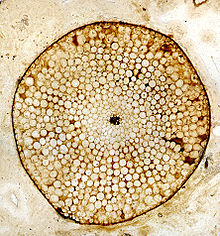CRSQ's Paper: The Origin of Trees Pt. 2
This is the show from Friday July 29th, 2011.
BEST QUOTE OF THE SHOW:
SUMMARY:

* Everything You Always Wanted to Know About Trees: Real Science Friday co-hosts Bob Enyart and Fred Williams discuss the current Creation Research Society Quarterly paper, The Origin of Trees, by Tom Hennigan and Jerry Bergman.
* Trouble for Tree Evolution: Some organisms don't readily fossilize because they're made of soft body parts. Trees are made OF WOOD. And they supposedly evolved from non-trees starting 370 million years ago. So since countless millions of fossils have been documented, it should be easy to trace the evolution of trees. Oops. It's not. Paleobotanists document that to them the evolution of trees is a great mystery that simply has not been documented in the fossil record. "The first trees existing in the fossil record were clearly trees," concludes Hennigan and Bergman (and a whole lot of other scientists). Also, modern resin and modern seeds appear in the fossil record before they supposedly evolved. Discrediting evolution is like shooting fish in an oak barrel. (And speaking of fish... perhaps we have an Origin of Fish show in our future!
 Today’s Resource: Getting the BEL Science Pack, learn and have a great time, support Bob Enyart Live, and save a lot of money, all at the same time! You can consider our BELScience Pack and enjoy:
Today’s Resource: Getting the BEL Science Pack, learn and have a great time, support Bob Enyart Live, and save a lot of money, all at the same time! You can consider our BELScience Pack and enjoy:
- Dr. Guillermo Gonzalez’ Privileged Planet (clip)
- Illustra Media’s Unlocking the Mystery of Life (clip)
- Walt Brown’s In the Beginning
- Bob Enyart’s Age of the Earth Debate between him and a geo-physicist, and
- Bob's Genesis: Creation verse-by-verse Bible Study!
And have you browsed through the entire Science Department in our KGOV Store? Check out especially Bob’s interviews with a great scientist in Walt Brown Week! You’ll also love Bob's debate aboutJunk DNA with famous evolutionist Dr. Eugenie Scott, and the superb kids' radio programming, Jonathan Park: The Adventure Begins! And Bob strongly recommends that you subscribe to CMI’s tremendousCreation magazine and Ken Ham's Answers magazine! Or to order any of our BEL and 3rd-party resources, just call us at 1-800-8Enyart.
This is the show from Friday July 29th, 2011.
BEST QUOTE OF THE SHOW:
My experience is geology students that I talk to, and sometimes professors, they don't like to talk about polystrate trees because one polystrate tree demolishes their theory of how that coal seam was formed.
SUMMARY:

* Everything You Always Wanted to Know About Trees: Real Science Friday co-hosts Bob Enyart and Fred Williams discuss the current Creation Research Society Quarterly paper, The Origin of Trees, by Tom Hennigan and Jerry Bergman.
* Trouble for Tree Evolution: Some organisms don't readily fossilize because they're made of soft body parts. Trees are made OF WOOD. And they supposedly evolved from non-trees starting 370 million years ago. So since countless millions of fossils have been documented, it should be easy to trace the evolution of trees. Oops. It's not. Paleobotanists document that to them the evolution of trees is a great mystery that simply has not been documented in the fossil record. "The first trees existing in the fossil record were clearly trees," concludes Hennigan and Bergman (and a whole lot of other scientists). Also, modern resin and modern seeds appear in the fossil record before they supposedly evolved. Discrediting evolution is like shooting fish in an oak barrel. (And speaking of fish... perhaps we have an Origin of Fish show in our future!
 Today’s Resource: Getting the BEL Science Pack, learn and have a great time, support Bob Enyart Live, and save a lot of money, all at the same time! You can consider our BELScience Pack and enjoy:
Today’s Resource: Getting the BEL Science Pack, learn and have a great time, support Bob Enyart Live, and save a lot of money, all at the same time! You can consider our BELScience Pack and enjoy:- Dr. Guillermo Gonzalez’ Privileged Planet (clip)
- Illustra Media’s Unlocking the Mystery of Life (clip)
- Walt Brown’s In the Beginning
- Bob Enyart’s Age of the Earth Debate between him and a geo-physicist, and
- Bob's Genesis: Creation verse-by-verse Bible Study!
And have you browsed through the entire Science Department in our KGOV Store? Check out especially Bob’s interviews with a great scientist in Walt Brown Week! You’ll also love Bob's debate aboutJunk DNA with famous evolutionist Dr. Eugenie Scott, and the superb kids' radio programming, Jonathan Park: The Adventure Begins! And Bob strongly recommends that you subscribe to CMI’s tremendousCreation magazine and Ken Ham's Answers magazine! Or to order any of our BEL and 3rd-party resources, just call us at 1-800-8Enyart.
Last edited by a moderator:



